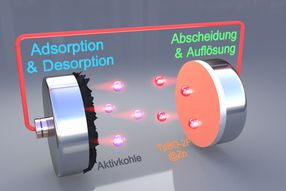Biomarker Detects Severe COVID-19 Early On
SARS-CoV-2-specific immune signature deciphered
Severe cases of Covid-19 can now be detected at an early stage. Researchers at the University of Zurich have identified the first biomarker that can reliably predict which patients will develop severe symptoms. This can help to improve the treatment of severe cases of COVID-19.

Symbolic image
Photo by camilo jimenez on Unsplash
Most people who are infected with SARS-CoV-2 develop no or only mild symptoms. However, some patients suffer severe life-threatening cases of COVID-19 and require intensive medical care and a ventilator to help them breathe. Many of these patients eventually succumb to the disease or suffer significant long-term health consequences. To identify and treat these patients at an early stage, a kind of “measuring stick” is needed – predictive biomarkers that can recognize those who are at risk of developing severe COVID-19.
First biomarker to predict severity of disease
A team led by Professor Burkhard Becher at the Institute of Experimental Immunology at the University of Zurich, working with researchers from Tübingen, Toulouse and Nantes, has now discovered such a biomarker – the number of natural killer T cells in the blood. These cells are a type of white blood cell and part of the early immune response. “The number of natural killer T cells in the blood can be used to predict severe cases of COVID-19 with a high degree of certainty – even on a patient’s first day in hospital,” says Burkhard Becher.
Targeted therapy thanks to precise immunopathogenesis
The new biomarker test helps clinicians decide which organizational and treatment measures need to be taken for patients with COVID-19, such as transfer to the ICU, frequency of oxygen measurements, type of therapy and treatment start. “Predictive biomarkers are very useful for making these decisions. They help clinicians provide patients suffering severe symptoms with the best care possible,” says Stefanie Kreutmair, first author of the study. “Our findings also make it possible to investigate new therapies against COVID-19.”
With the help of high-tech
The rapid deterioration in the health of COVID-19 patients is caused by an overreaction of the body’s immune system. “The body produces small proteins called cytokines at a much higher rate, which leads to a ‘cytokine storm’ and triggers massive inflammation. Immune cells invade the lungs, where they disrupt gas exchange,” explains Becher. To detect the immune cells and cytokines in patient samples, the UZH researchers used high-dimensional cytometry. This technology enables researchers to characterize many surface and intracellular proteins in millions of individual cells and process them using computer algorithms.
SARS-CoV-2-specific immune signature deciphered
Many other pathogens besides SARS-CoV-2 can cause pneumonia – and thus spark an immune response. The immune response triggered by COVID-19 has been studied extensively, but the exact nature of the immune response to SARS-CoV-2 has, to date, been unclear. To characterize this response, the researchers also analyzed blood samples of patients with severe pneumonia driven by a pathogen other than the novel coronavirus. By comparing the immune responses in COVID-19 patients with those of the control group, the researchers were able to determine the unique characteristics of the SARS-CoV-2 immune response.
“The immune responses to the various pneumonias are very similar and part of the body’s general inflammatory response, as often observed in patients in intensive care. When it comes to COVID-19, however, T cells and natural killer cells display a unique behavior and describe a kind of pattern in the immune system – the immune signature specific to COVID-19,” explains Becher.
Original publication
Stefanie Kreutmair, Susanne Unger, Nicolás Gonzalo Núñez, Florian Ingelfinger, et. al.; "Distinct immunological signatures discriminate severe COVID-19 from non-SARS-CoV-2-driven critical pneumonia"; Immunity (in press; 2021)























































